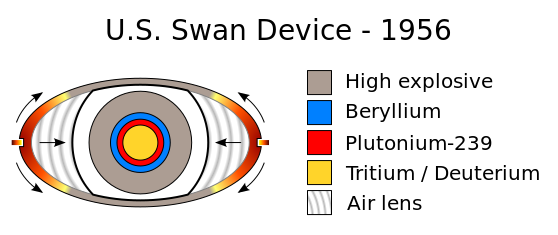Swan (nuclear primary)
Swan was a United States test nuclear explosive, which was developed into the XW-45 warhead.[1]
It was tested standalone on June 22, 1956, in shot Redwing Inca.[1] It was tested again as the primary of a thermonuclear device on July 2, 1956, in shot Redwing Mohawk.[2] Both tests were successful.
Design features[edit]
The Swan device is the first design to incorporate a two-point ignition hollow-pit air-lens implosion assembly together with fusion boosting.
The Swan device had a yield of 15 kilotons,[1] weighed 105 pounds (48 kg), and had a (symmetrical) ovoid (non-prolate) shape with a diameter of 11.6 inches (29 cm) and a length of 22.8 inches (58 cm), a length to diameter ratio of 1.97.[2]

The above schematic illustrates what were probably its essential features.
References[edit]
- ^ a b c http://nuclearweaponarchive.org/Usa/Tests/Redwing.html "Inca .. Yield: 15.2 kt. UCRL test of a multi-application boosted tactical nuclear warhead prototype named Swan. This design was later developed into the XW-45 warhead. The predicted yield was 10-15 kt."
- ^ a b http://nuclearweaponarchive.org/Usa/Tests/Redwing.html "Mohawk. Yield: 360 kt This UCRL thermonuclear device used a boosted "Swan" primary and "Flute" secondary. The device was 15 inches in diameter, 46.2 inches long, and weighed 1116 lb. The primary was 11.6 inches by 22.8 inches and weighed 105 lb."


 French
French Deutsch
Deutsch